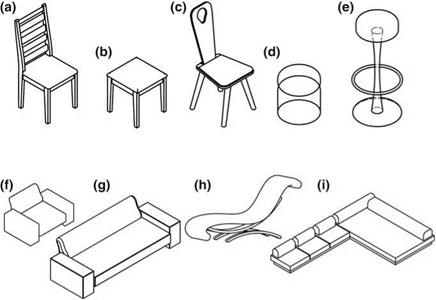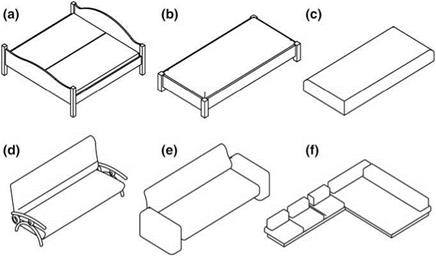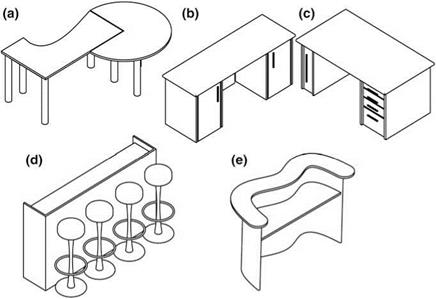In terms of functionality, furniture can be divided into the following groups:
• for sitting and lounging,
• for reclining,
• for working and eating meals,
• for learning,
• for storage,
• multifunctional furniture and
• complementary furniture.
Each of the given groups is characterised by specific properties and requirements:
• of exploitation, that is the character of the performed task,
• anthropotechnical, that is adjusting the user’s anthropotechnical characteristics to the technical features of the operational object,
• sanitary and hygienic,
• pedagogical and
• construction.
A group of furniture for sitting and lounging comprises typical chairs, tabourets, stools, pouffes and bar stools, which do not or only partially provide support for the user’s back (Fig. 2.3a-e), as well as armchairs, sofas, chaise lounges and corner sofas, supporting the whole body or its major part (Fig. 2.3f-i).
Furniture for reclining should ensure comfortable and continuous support of the human body in a reclining position. There are, however, structures that not only meet this basic function, but also provide support for the body in a sitting position. For this reason, furniture for reclining can be divided into two subgroups (Fig. 2.4):
• only with reclining function, such as beds, couches and mattresses (Fig. 2.4a-c) and
• with a reclining and sitting function, such as folding sofas, sofas and corner sofas (Fig. 2.4d-f). In this subgroup of furniture, the change of function can be achieved by using fittings and accessories that enable to transform the piece of
|
Fig. 2.3 Furniture for sitting and lounging: a chair, b tabouret, c stool, d pouffe, e bar stool, f armchair, g sofa, h chaise lounge, i corner sofa |
|
Fig. 2.4 Furniture for reclining: a bed, b couch, c mattress, d folding sofa, e sofa, f corner sofa |
furniture and unfold or fold the reclining surface. However, if the dimensions of the seat are significant, the reclining function can be provided without the need for transforming the geometry of the piece.
The group of furniture for working and eating meals mainly consists of tables, table add-ons, desks, side tables, buffets and reception bays (Fig. 2.5). Tables can be used to work, study, prepare and consume meals, games, as well as bases for apparatus, instruments, flowers or lighting. Here, we distinguish tables for the dining room, kitchen, conference rooms, construction offices, trade offices, editorials of magazines, schools, kindergartens, etc. The tables for dining rooms can usually change the geometry of the work surface, increasing its length and at the same time, area for future users. Tables and desks for offices usually have a fixed geometry of the work surface, but they have step or stepless adjustment of its position height. The change of the geometry of the work surface of office furniture is provided by applying side tables and add-ons. These furniture pieces are designed by particularly considering the arrangement of devices and objects that are the basic equipment of the workplace, including the computer, telephone, notepad, writing supplies, binders and other office accessories requiring compartments, drawers, boxes, slides, hangers and top extensions. A problem at the design stage of the integration of form, function and structure of the furniture piece is providing an exit and hiding cables delivering certain media to electrical devices.
Reception bays are a unique type of furniture designed to work, for they are an obvious flagship of an institution—they stand in the lobby or the hallway, where clients are welcomed. They should not only enable the performance of precision work in a sitting position, but also hard work in a standing position.
|
Fig. 2.5 Furniture for work and dining: a table and table add-on, b side table, c desk, d buffet, e reception bayt |
Furniture for learning is primarily benches, pupil tables, drafting tables and davenports (Fig. 2.6). When designing furniture belonging to this group, in particular school furniture, one must anticipate a different than normative structure load and guarantee the furniture’s adequate stiffness, strength and stability. One must also remember to use such structural components for which the designer has certificates of their complete non-toxicity.
The group of storage furniture represents cabinets, bookcases, shelves, dressers, chests of drawers, cabinets, containers, dressing tables and library bookcases (Fig. 2.7). This is most numerous and diverse group of furniture, with a wide variety of forms and dimensions depending on the type, shape and size of the stored items.
|
Fig. 2.6 Furniture for learning: a bench, b pupil’s table, c drafting table, d davenport |
|
Fig. 2.7 Furniture for storage: a wardrobe, b bookcase, c shelf, d dresser, e chest of drawers, f buffet, g container, h dressing table, i library bookcase |
Depending on the degree of connection with the room, furniture from this group can be divided into mobile (not connected to the construction elements of the room, e. g. containers, chests of drawers, cabinets, buffets and chests) and stationary (connected impermanently with the construction elements of the room, e. g. wall cupboards, shelves, partitions or tall standing cupboards).
Multifunctional furniture originated from the need to meet the many different needs of users. These needs appeared for a number of reasons. The first were the dreams of wealthy clients of having products that were unique in form, with surprising technical solutions, and enabling users to meet several practical administrative needs. Modern multifunctional furniture pieces are often adapted by necessity to minimum living space, the nature of work and financial possibilities of future owners. Usually, multifunctional furniture can be found among sofas with a reclining function, couch beds, couch shelves, escritoires for work and storage (Fig. 2.8).
The group of complementary furniture constitutes flower beds, covers, partition walls and side tables. Mostly, they are manufactured for individual needs of clients who are furnishing their rooms completely and expecting a uniform form, construction and technology of manufacture in order to maintain consistency of the interior’s look and aesthetics.







